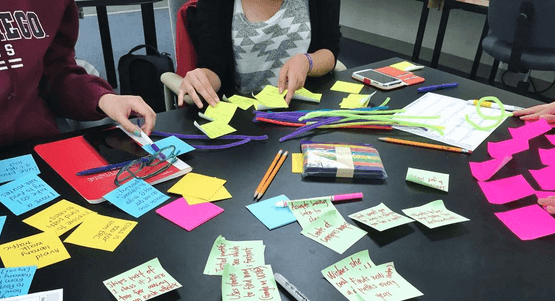
In the lower level of the Humanities and Social Sciences Building, Room 1346 is brimming not only with office chairs and neon post-it notes, but also ideas. The space houses Design.UCSD, aka COGS 198, a class dedicated to solving campuswide issues while expanding the university’s community of aspiring designers. On Tuesday nights, 24 students gather here for one of the only student-run courses at UCSD and work on computer interfaces and other mediums to solve user-driven problems.
The pilot project, a four-unit independent-study course under the cognitive science department, is based off the former design club User Experience San Diego. Building off UXSD and taking the best features of that organization, Design.UCSD emerged as an amalgam of student organization, independent study and creative brainstorm session.
Design.UCSD President Thomas Chang, a cognitive science sophomore, leads the class with a clear vision to expand the design community.
“We are trying to redefine design here on campus,” Chang told the UCSD Guardian. “I felt like design is so big and it encompasses so many disciplines. That’s why we decided to revamp [UXSD] as Design.UCSD. We managed to start from ground zero, but we are bigger than ever.”
Vice President and junior cognitive science major Lizzy Cowan, who runs the class with Chang, says they were inspired to develop the course by an annual UXSD design competition.
“We wanted to make the design competition slightly more structured and give people credit for it,” Cowan told the Guardian. “The unique thing about the class is that Thomas and I are enrolled in the class as well, but our project is the class. Every week, we are changing it and prototyping it.”
Although the class began as a competition for design majors — formally the cognitive science human-computer interaction major — Cowan and Chang opened the class for all majors and required no prerequisites other than an interest in design. Their students include cognitive science majors mixed with economics, biology and engineering majors all working together in small groups.
“We created the teams without letting [the students] choose their [own] teams. And we wanted them to disagree since they all come from different backgrounds. We wanted all these different minds to start confrontation and see how that goes,” Cowan said.
Each group of four specializes on a different issue pertinent to the UCSD community, such as dining-hall composting, collaborative spaces, transportation and creating an adaptive four-year plan. Chang and Cowan lead the students through exercises, such as creating affinity diagrams. These diagrams, made mostly up of colored Post-it notes, cover the walls of the classroom and help organize raw data and observations into usable patterns. Every week, groups post on Medium, a blog website created for the course, to update their findings as they narrow down the underlying problems and come closer to hopeful solutions.
“What we want to drive home with the course is [to] encourage students to wrestle with ambiguity,” Chang said. “When you are out in the real world, the actual problem isn’t given to you; it’s something that you have to uncover yourself. You have to pick the right problems to solve.”
During the three-hour class, students tackle issues with the guidance of mentors from design companies around San Diego. Many alumni involved in UXSD, now industry professionals, return to guide groups through the design process. Chang and Cowan have also developed relationships with companies — like Digital Telepathy, an innovative design firm in Downtown San Diego — along the way. The Design Lab on campus, run by Don Norman and other industry professors, has also helped by providing funds and mentors to the emerging community.
“The Design Lab is trying to drive design on this campus from top down, from the administration and faculty side. For us as an org, we are starting from bottom up — from the students,” Chang said.
With the support of the faculty and mentors, the Design.UCSD participant can focus on researching the needs of the other students and making prototypes. The next step is applying these ideas to the campus by working with the faculty and departments. One group has even gotten approval from Housing, Dining and Hospitality to use a full dining hall to prototype its idea to minimize food waste.
As the quarter begins to wrap up, Chang and Cowan prepare to offer the course next fall using what they learned this year as a base. Additionally, students who do not finish their projects have the option of re-enrolling to continue to prototype and research as Chang and Cowan continue their own project.
“Next quarter, it would be cool to even call the class a competition. To make it a contest again would give people more drive,” Cowan added.
Design.USCD continues to evolve to help grow the design community while it encourages students of all majors to do so as well by joining the organization or taking the class. The main lesson in this classroom is that problem-solving and design can be applied by all majors to fix problems of our school.
“Everyone is a designer in their own way,” Cowan said.












